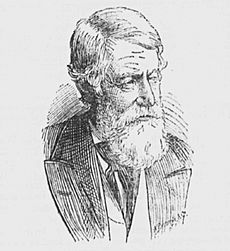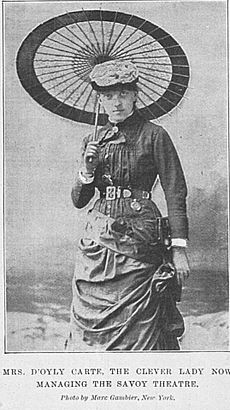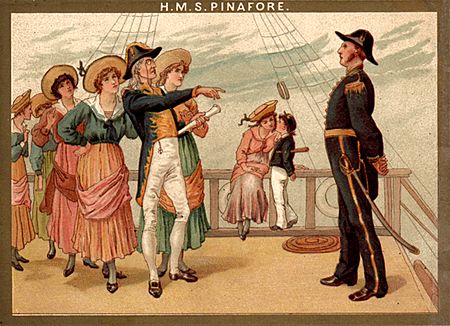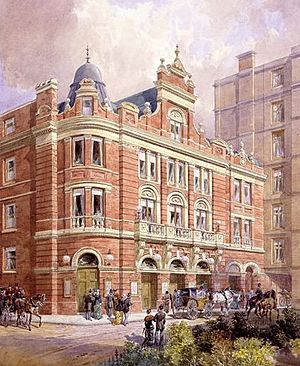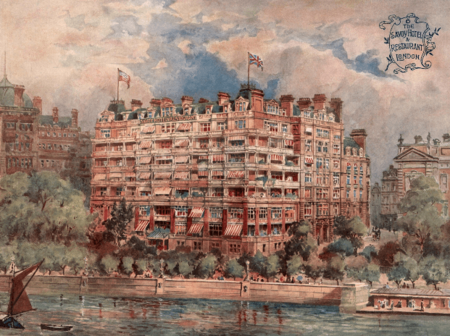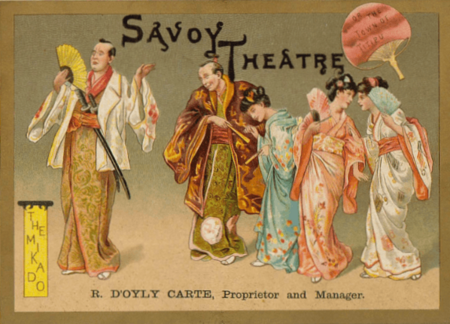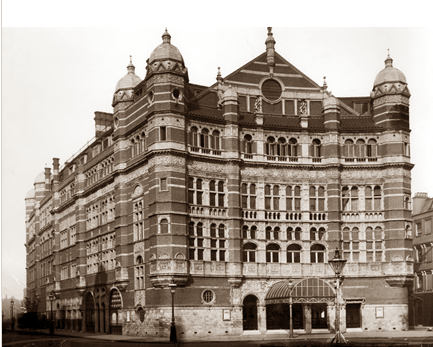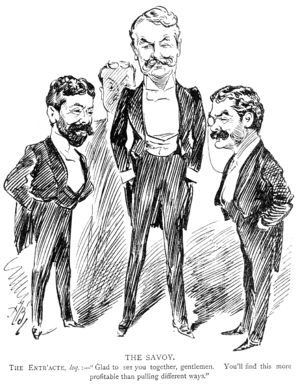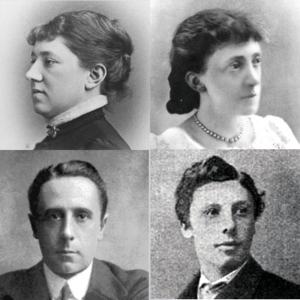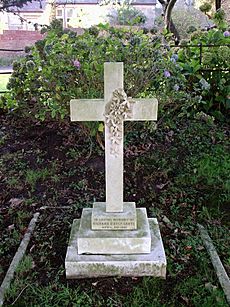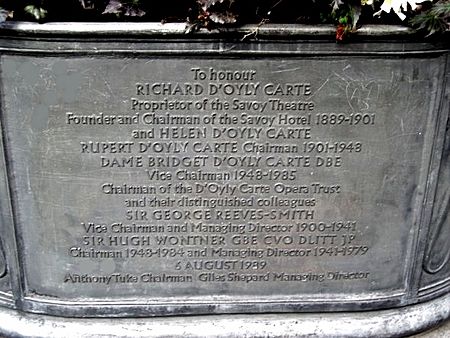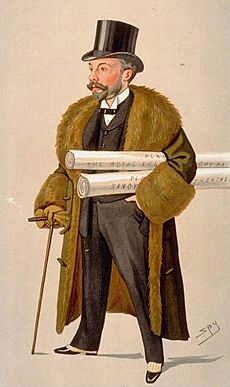Richard D'Oyly Carte facts for kids
Richard D'Oyly Carte (born May 3, 1844 – died April 3, 1901) was an important English businessman, theatre manager, and composer during the Victorian era. He built two famous London theatres and started a hotel business. He also created an opera company that lasted for over 100 years.
Carte began his career working for his father, who was in the music business. As a young man, he composed music and conducted. But he soon focused on helping other artists with their careers through his management agency. Carte believed that English comic operas, which were fun and family-friendly, could be as popular as the French shows common in London.
To make this happen, he brought together the writer W. S. Gilbert and the composer Arthur Sullivan. He helped them work together on 13 famous operas, known as the Savoy operas. He started the D'Oyly Carte Opera Company and built the modern Savoy Theatre especially for their shows.
Eight years after the Savoy Theatre opened, Carte built the Savoy Hotel next door. He later bought other fancy hotels. In 1891, he built the Palace Theatre, London (first called the Royal English Opera House). He hoped it would be a home for new English grand operas, but this dream didn't fully come true.
Still, his partnership with Gilbert and Sullivan, and his careful management, led to hugely successful musical shows. His opera company, later run by his wife Helen, then his son Rupert, and granddaughter Bridget, kept these works popular for more than a century. They are still performed often today.
Contents
Early Life and Family
Richard D'Oyly Carte was born in London on May 3, 1844. He was the oldest of six children. His father, Richard Carte, was a flautist (someone who plays the flute). His mother was Eliza Jones.
In 1850, Carte's father joined a company that made musical instruments and published music. The company later became Rudall, Carte & Co. The family moved to a large house in north London. Carte's mother loved art, music, and poetry, and she made sure her children learned about these things. Young Carte studied the violin and flute. The family even spoke French at home two days a week, and his parents often took the children to the theatre.
Carte went to University College School from 1856 to 1860. In 1861, he did very well on an exam for University College London. However, he decided to join his father's business instead, along with his brother Henry. Since his father's name, Richard Carte, was already well known in music, Carte started calling himself "D'Oyly Carte" or "R. D'Oyly Carte." He continued to study music and even composed some pieces. He also acted in amateur plays.
Starting His Theatre Career
Between 1868 and 1877, Carte wrote music for his own songs and instrumental pieces. He also wrote three short comic operas. In 1871, he conducted a show called Cox and Box by Arthur Sullivan. Carte's musical skills were very helpful later on, as he could audition singers himself at the piano.
In the late 1860s and early 1870s, Carte began to build a business managing opera singers, concert performers, and lecturers. He managed about 200 artists, including famous names like Charles Gounod and Oscar Wilde. People said Carte had a sharp business sense and a friendly way of dealing with people. He knew how to make money and wasn't afraid to take smart risks.
Founding His Opera Company
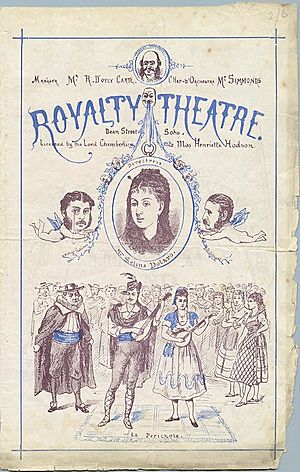
In 1874, Carte rented the Opera Comique theatre in London. He wanted to create a permanent home for light opera in London. He believed the public was ready for a higher quality of musical entertainment.
Carte's big dream was to create a type of high-quality, family-friendly English comic opera. At the time, London stages were mostly filled with simple comedies or French operettas. He realized his own writing skills weren't enough for this task. He once wrote to W. S. Gilbert that he was "simply the tradesman who sells your works of art."
In 1875, Carte became the business manager of the Royalty Theatre. To make the evening shows longer, he needed another short play. He remembered a comic opera script called Trial by Jury that W. S. Gilbert had shown him in 1873. He also knew that Arthur Sullivan had worked with Gilbert before. So, Carte suggested that Sullivan write the music for Trial by Jury.
Trial by Jury, a funny story about an English courtroom, was a surprise hit! It became the first step in Carte's plan to create a new kind of English comic opera.
In 1877, Carte hired a new actress named Helen Lenoir. After a few weeks, she joined Carte's agency as an office worker. She slowly became very important in his business and personal life. People said her personality balanced his perfectly.
Encouraged by Trial by Jury's success, Carte found four investors and formed the "Comedy Opera Company." This allowed him to rent the Opera Comique again and ask Gilbert and Sullivan to write a new opera. Their first show for this company was The Sorcerer in 1877. This time, Gilbert, Sullivan, and Carte could choose their own actors, many of whom came from Carte's agency. The show proved that family-friendly English comic opera had a bright future.
The Sorcerer was followed by H.M.S. Pinafore in 1878. It was a huge success, but a heat wave in London made business slow. Carte's partners wanted to close the show. But Carte and Sullivan worked hard to promote it, and it became a big hit.
Carte convinced Gilbert and Sullivan that they should form their own business partnership. In 1879, they each put in £1,000 and created "Mr Richard D'Oyly Carte's Opera Company." They agreed to share the profits equally after expenses.
On July 31, 1879, the old Comedy Opera Company tried to take back the Pinafore set during a performance! This caused a famous fight backstage. But Carte's stagehands protected the scenery. The old company tried to put on their own Pinafore show, but it wasn't as popular. Carte, Gilbert, and Sullivan won the legal battle over the rights. From then on, their new company (later called the D'Oyly Carte Opera Company) was the only official producer of Gilbert and Sullivan's works.
Building Theatres and Hotels
H.M.S. Pinafore was so successful that Carte sent two companies to perform it across Britain. It ran for 571 shows in London, which was one of the longest runs for a musical show at that time.
In America, over 150 unofficial productions of Pinafore appeared. Because American law didn't protect foreign artists' copyrights then, Carte, Gilbert, and Sullivan couldn't get money from these shows. To try and stop this "piracy," Carte traveled to New York with the authors and their company in 1879 to present an "authentic" production of Pinafore. Helen Lenoir made many trips to America to manage these productions.
To protect their next opera, The Pirates of Penzance, Carte and his partners opened it in New York on December 31, 1879, before its London premiere. They hoped this would stop others from copying it. The Pirates was an instant hit in both New York and London.
The next Gilbert and Sullivan opera, Patience, opened in April 1881 and was another huge success. It made fun of the "aesthetic movement" in England. To help promote it in America, Carte sent the young poet Oscar Wilde on a lecture tour to explain the movement.
Carte had been planning for years to build a new theatre for English comic opera, especially for Gilbert and Sullivan's shows. Using profits from their operas, he bought land in London in 1880. He built the Savoy Theatre there, which opened in 1881. It was a very modern theatre, setting new standards for technology and comfort. It was the first public building in the world to be lit entirely by electric lights! It could seat almost 1,300 people.
Patience was the first show at the new theatre. Carte even broke a glowing lightbulb on stage to show the audience how safe the new electric lights were. Carte and his manager introduced new ideas at the theatre, like free program booklets, an orderly line system for tickets, and tea served during the break. The last eight Gilbert and Sullivan operas premiered at the Savoy, and all their works became known as Savoy operas.
The Savoy Hotel, designed by architect Thomas Edward Collcutt, opened in 1889. It was paid for with profits from The Mikado. It was the first hotel with electric lights and electric lifts (elevators). In the 1890s, under its famous manager César Ritz, it became a very well-known luxury hotel. It made more money for the D'Oyly Carte family than any other business, including the opera company. Carte later bought and improved other famous hotels like Claridge's (1893) and The Berkeley (1900).
The Opera Company's Best Years
While Gilbert and Sullivan were writing their operas, Carte also produced other shows and plays to fill the Savoy Theatre. Many of these were shorter "companion pieces" shown before the main opera. Carte and Helen Lenoir also continued to run his management agency. For example, in 1881, Carte was managing two productions of Patience, two companies touring with other Gilbert and Sullivan operas, and several other shows and tours in Europe, America, and Australia.
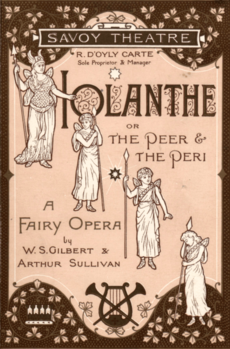
Carte also started allowing amateur theatre groups to perform the operas for which he held the rights. This made the works even more popular and helped sell more sheet music. This greatly helped amateur theatre in general. Before this, professional actors often looked down on amateur groups. But after Gilbert and Sullivan operas became popular with amateur companies, professionals saw them as good training schools for the stage.
After Patience, Carte produced Iolanthe, which opened in 1882. In 1883, he signed a five-year agreement with Gilbert and Sullivan, requiring them to write new operas for him. Sullivan, who had been knighted in 1883, felt pressure to write more serious music and soon regretted signing the contract. However, Carte and Helen often helped smooth over their disagreements.
Their next opera, Princess Ida, opened in 1884. When it didn't do as well at the box office, Carte asked his partners for a new opera. Gilbert eventually came up with a new idea.
While waiting for the new work, Carte brought back older Gilbert and Sullivan operas. The new opera became their most successful: The Mikado, which opened in March 1885. It made fun of British society by setting the story in a fictional Japan. The Mikado ran for 672 performances at the Savoy Theatre, becoming the longest-running hit for the partnership. It was incredibly popular worldwide and is still the most performed Savoy Opera.
Their next opera, Ruddigore (1887), was a financial success but not as huge as The Mikado. Carte then showed revivals of earlier operas for almost a year. Gilbert and Sullivan then created The Yeomen of the Guard, which premiered in October 1888 and ran for over a year.
Carte asked for another new work. Sullivan was still hesitant to write another comic opera. They agreed that they would write a light opera for the Savoy, and Sullivan could also work on a grand opera that Carte would produce at a new theatre he planned to build. The new comic opera was The Gondoliers, which opened in December 1889. It became one of their biggest successes, running for 554 performances.
During these years, Carte was more than just a theatre manager. He was deeply involved in casting, finding designers, directing shows, and managing touring companies. He was known for his sharp eye for detail. The high quality of Carte's productions made them popular everywhere. He sent touring companies across Britain, to America, Europe, and other places. Even Queen Victoria honored the company by asking for a special performance of The Gondoliers at Windsor Castle in 1891.
Later Years and Legacy
In 1890, during the run of The Gondoliers, Gilbert found out that Carte was charging the partnership for theatre maintenance expenses, like a new £500 carpet, instead of paying for them himself. Gilbert was very angry and felt Carte had been dishonest. Gilbert sued Carte, and Sullivan sided with Carte. Gilbert won the lawsuit, but the partnership broke up.
Carte's first show at his new Royal English Opera House was Sullivan's only grand opera, Ivanhoe, which opened in January 1891. It ran for 155 performances, a record for an opera. But when it closed, Carte had no new show ready, so the opera house had to close. He later sold the opera house at a loss. It was then turned into a music hall, which became the Palace Theatre.
Because of the quarrel, Gilbert had said he wouldn't write for the Savoy anymore. When The Gondoliers closed in 1891, Carte needed new writers. He produced other shows, but none were as successful as the Gilbert and Sullivan operas.
Carte and Helen eventually tried to bring Gilbert and Sullivan back together. After several attempts, they finally reconciled. In 1893, Gilbert and Sullivan created their second-to-last collaboration, Utopia, Limited. This was Carte's most expensive production, but it only ran for 245 performances.
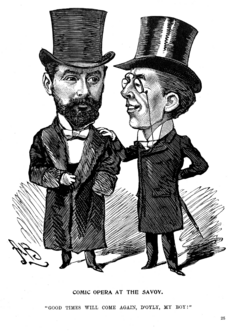
Their last collaboration, The Grand Duke (1896), was their only financial failure. After this, Gilbert and Sullivan never worked together again. At the Savoy, Carte produced other shows and revivals of the Gilbert and Sullivan operas.
Even though the 1890s brought some disappointments in the theatre, Carte's hotel business grew and did very well. He bought and rebuilt Simpson's-in-the-Strand and Claridge's Hotel.
Throughout the late 1890s, Carte's health declined. Helen took on more and more responsibility for the opera company. In 1894, Carte hired his son, Rupert, as an assistant. In 1899, Carte had a new success with The Rose of Persia, which ran for 213 performances. Neither Carte nor Sullivan lived to see the next show, The Emerald Isle.
Personal Life
Carte was married twice. His first wife was Blanche Julia Prowse (1853–1885). They married in 1870 and had two sons, Lucas (1872–1907) and Rupert. Blanche died in 1885. In 1888, Carte married his assistant, Helen Lenoir. Their wedding was held at the Savoy Chapel, with Arthur Sullivan as the best man. Rupert later joined his father's business. Lucas became a lawyer.
Carte's London home was near the Savoy. He loved art and asked his friend, the artist James Abbott McNeill Whistler, to decorate his house. Carte also loved new technology and installed the first lift (elevator) in a private house in England. Around 1890, he bought a small island in the River Thames called Folly Eyot, which he renamed D'Oyly Carte Island. He built a large house there and used it as a home.
Death and Legacy
Richard D'Oyly Carte died at his London home in 1901, just before his 57th birthday. He is buried in the churchyard of St Andrew's in Fairlight, East Sussex. A memorial service was held for him at the Chapel Royal of the Savoy. He left behind a large estate.
Carte played a key role in raising the status of British theatre. He helped make it a respected art form. People like Gilbert even received knighthoods. Many people said that Carte created a new type of English comic opera and made theatre productions into a fine art. His influence on the development of modern musical theatre was huge.
Carte also helped make hotels respectable and popular. The Savoy Hotel became a meeting place for London's high society. It encouraged people, including ladies who were once afraid to dine in public, to enjoy meals and parties there.
Carte left the theatre, opera company, hotels, and his other businesses to Helen. She continued to manage the Savoy Operas in Britain and overseas. Rupert became chairman of the Savoy Hotel by 1903.
When Helen died in 1913, she passed the family businesses to Carte's son, Rupert. He continued the hotel business and expanded it in London. The Savoy Group stayed under the Carte family's control until 1994. Carte's hotels are still among the most famous in London.
Rupert D'Oyly Carte updated the opera company's productions and brought back London seasons starting in 1919. He also continued tours across Britain and to other countries. When Rupert died in 1948, his daughter Bridget D'Oyly Carte took over. However, the rising costs of putting on professional light opera without government support eventually became too much. Bridget had to close the company in 1982.
Even so, the Gilbert and Sullivan operas are still performed very often today around the world. Carte's vision of wholesome and fun light operas that celebrate Great Britain continues to live on.
See also
 In Spanish: Richard D'Oyly Carte para niños
In Spanish: Richard D'Oyly Carte para niños


